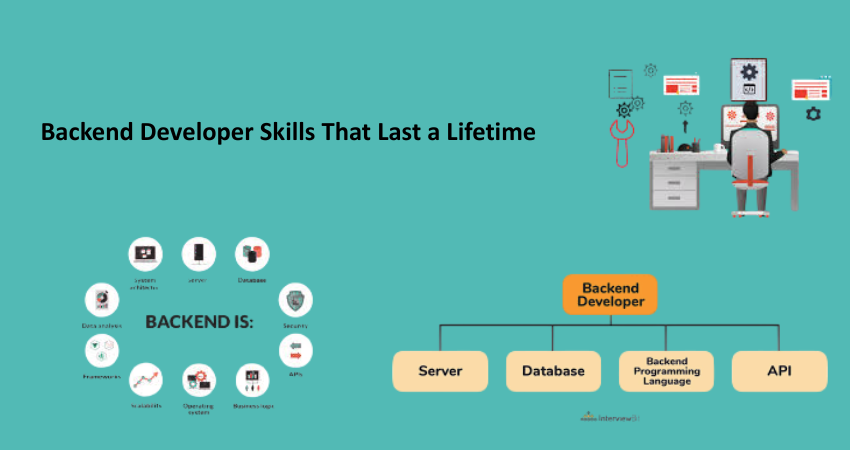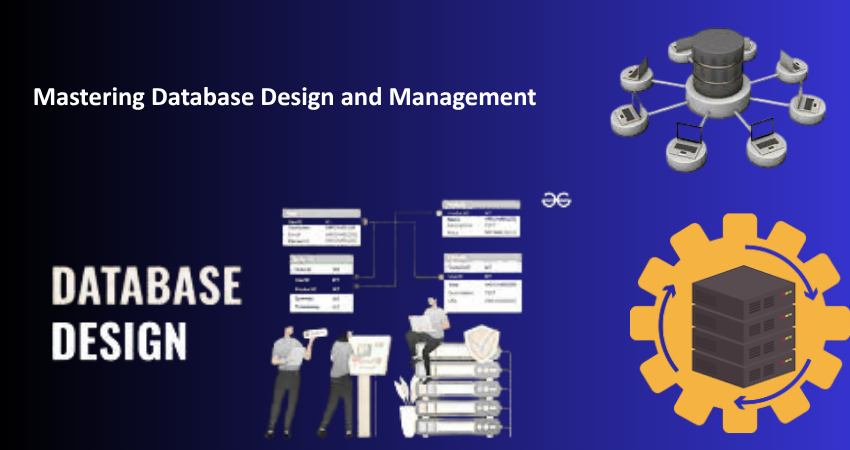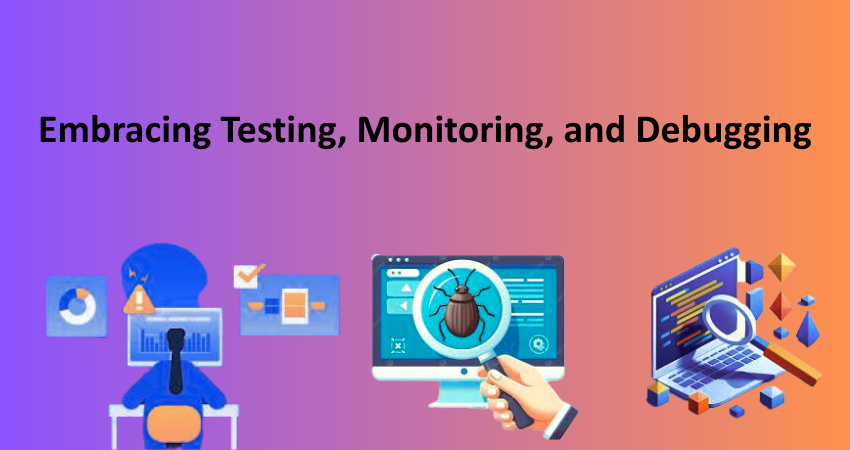
Understanding the Fundamentals of Backend Architecture
The Core of Application Logic and Data Flow
It is the backend logic through which goes all the user interaction, all data processing, and between front-end interfaces with the database communication. One of the essential skills of a backend developer is the understanding and drawing architecture of a system. It includes knowing how servers, databases, APIs, and services operate within themselves to ensure a user experience is seamless. It is not merely coding; it is actually designing the effective and scalable logic flow as well as the functions of the components into a unit and pointing the bottlenecks.
A backend developer that knows the architecture of the system can spot problems even before they occur. They know the tradeoffs of monolithic versus microservices architectures, the good RESTful APIs, and modular versus reusable code. Thus, this foresight leads to even more solid applications that are simpler to scale, maintain, and upgrade with time. The understanding of backend architecture provides the user with the foundation to delve into higher-level topics like containerization, load balancing, caching strategies, and asynchronous processing-all of these things are vital in designing a durable backend system so that it can last a long time.
Why Scalability and Reliability Matter Most
Back-end developers are known for their experience in scaling systems up and down according to the pressure exerted on the system for an extended period. With the rise of businesses and escalating user demand, back-end systems ought to accommodate extra traffic without sacrificing reliability. Standard considerations of scalability include selecting an appropriate database engine, writing optimized queries, optimizing server settings, and understanding message queuing for asynchronous activities like RabbitMQ or Kafka. Designing for scale means that by the time the user issues start becoming manifold, no major rewriting will have to go on.
The set of paradigms of availability and reliability are equally significant: How often can your system be warranted to be available and operate error-free? This involves good error handling and input validations, exception tracking, and testing and logging systems. Thoughts about retries, circuit breakers, and fallbacks are pondered upon while confronting the built-in unreliability of distributed systems. A golden skill to have for backend engineer’s is the art of building systems that users trust: fast, less buggy, and fault-tolerant. It is not an appeal to new fame but a confidence in rigorous time-based engineering theories wisely and prudently infused with foresight.
Mastering Database Design and Management

Building and Optimizing Data Structures
The backend system is only as good as its database. The development of more sustain-sided-backend skills is when developers go beyond running queries to learning adequate database schema design for the true nature of the data and business logic. This requires an understanding of distinguishing characteristics between relational databases like PostgreSQL or MySQL and non-relational options such as MongoDB or Cassandra. A well-formed schema is necessary to ensure proper data storage for efficiency, clarity of relationships between data, and the absence of overhead in running queries.
Database normalization, indexing, and query optimization are essentially the skills that promote redundancy-elimination, speed, and long-term system maintainability. Indexes enhance up-query performance but may hurt down-write performance; balancing these decisions is crucial. Backend developers must learn about the ramifications of choosing one datatype as opposed to another, setting constraints, and designing for referencing integrity. Distributed systems need to know such skills like partitioning of data, replication, and eventual consistency for effectively managing data at scale—these are not just the means but, rather, are the lifeline for building scalable and reliable software.
Long-Term Data Integrity and Security
Security and data integrity have a close hand-in-hand relationship when it comes to backend database administration. Long-lasting skills in any backend developer’s portfolio include protection of data against unauthorized access or damage or loss thereof. It means understanding encryption while in rest and transit, the application of role-based access controls, and following best practices for securing database connections. Such compliance would naturally align with GDPR or HIPAA or other such norms directing the way sensitive data will be stored and accessed.
Integrity is not limited to validation alone but also ensures that all the layers in the application are consistent with each other. Integrity must be enforced by keys, constraints, transaction management, and backups. It is the knowledge of how to roll back a transaction in case of failure or restore from backup in case of a breach that can turn what would have been a mere inconvenience into what has proved to be catastrophic data loss. Backend developers who build systems with a focus on integrity and strong security will be building systems meant to remain: systems in which users and businesses are inclined to trust for decades.
Mastery of APIs and Communication Protocols
REST, GraphQL, and Beyond
API management and design would probably find its scope as one of the most lasting backend skills in modern programming. It is more of a bridge between the front end and the backend, without which a modern programmer would not know any better. RESTful APIs have always been magic words, and it takes understanding HTTP methods such as GET, POST, PUT, and DELETE, status codes, and content negotiation within the APIs. A good REST API is predictable, contingent, and stateless; this is to make sure that the developer’s usage of the API is efficient and with a minimum time of confusion.
GraphQL is considered to be even more potent in terms of offering the client control in determining the data returned to it by the server. Rather than multiple endpoints handling very specific requests, a single endpoint will be able to handle many different queries. This multi-purpose endpoint usage is best suited for mobile and dynamic front-end applications. Knowing when REST is to be used and when to implement GraphQL is a maturity level that developing backend design decisions have reached. WebSockets are also very important to understand in real-time applications and how long polling or server-sent events would be used to get live updates. All backend developers are sure to have a high demand for their keeping knowledge about communication protocol because their systems is what make apps really interactive and responsive.scalable.
Authentication, Authorization, and API Security
As soon as you expose an API, you expose your backend to the world, so securing it becomes a big priority. Any backend developer’s lifelong skill is to authenticate users correctly and authorize their actions. This starts from the understanding of sessions, tokens (JWTs), OAuth 2.0, OpenID Connect, and API key management. Improper authentication implementation is one of the common maladies facing modern applications, leading to extremely unsafe situations if abused.
Preventing abuse and protecting the sanctity of your system is rate limiting, CORS policies, and input validation and sanitization. Also, putting in place proper logging and monitoring is essential to detect any suspicious actions. Secure headers, HTTPS-enforced, and making sure no sensitive information lands in the logs or error messages all bring down the attack surface even more. These API security measures are unflashy-but they are critical. They show a developer is committed to safe years, not just functional ft. Secure APIs mean safer users, more trustful platforms, and less emergency down the line.
Embracing Testing, Monitoring, and Debugging

The Value of Automated Testing
Making the proper well-Tuned-skilled backend developer in everything includes writing some automated tests, mainly unit and integration tests, to ensure that even the slightest function is capable of meeting expectations without any regressions in changes. Writing repeatable and reliable tests is possible through the following frameworks: MOCHA (Node.js), PyTest (Python), Junit (Java), or RSpec (Ruby). Well-tested applications allow developers to release their features faster and more reliably.
Testing isn’t just a box to tick; it’s a mindset. It helps them to think through edge cases, understand their logic more and earn time away from fixing defects in production. Usually, any Continuous Integration (CI) pipeline consists of automated tests that will allow every pull request to maintain all needed quality standards by the time it gets deployed. Eventually, the cost of the investment in testing pays dividends in less downtime, simpler maintenance, and greater confidence from the team members. Testing is what makes backend code write functionality into smooth data engineering.
Real-Time Monitoring and Effective Debugging
A code, once online, has to be monitored meticulously for performance and reliability. Therefore, tools of observability like Prometheus, Grafana, DataDog, New Relic, etc. come into play. Backend developers should be equipped with knowledge of using logging tools such as ELK stack (Elasticsearch, Logstash, Kibana), Fluentd, or Graylog to collect live application logs and monitor against anomalies. All these pieces of the puzzle will help in diagnosing memory leaks, spikes in latency, or even failures within a system well before a small issue blows up into a big one.
In a backend environment, debugging is more complicated most of the time than in the front end, because most of the failures remain silent until they start causing critical issues. Abled developers will put logging in key points of their application, trace the CPU usage and Disk I/O and Network Traffic among metrics tracked, and finally determine error tracing across services in a distributed environment. When things break, and off course broken they would be more than often these developers would be adept in relating the situation to their debugging skills and monitoring skills in resolving such. These skills will keep a distinction between reactive firefighting and proactive maintenance and turn up to be invaluable over a developer’s entire career.
Investing in Continuous Learning and Adaptability
Staying Relevant in a Changing Landscape
The world of technology is continuously changing, be it languages or frameworks that get deprecated as time passes, or changes in best practices themselves. Indeed, the only skill which is for a lifetime is that of learning, adapting, and growing constantly-in other words, which won’t be limited to a particular technology. Staying updated with documentation, blogs, podcasts, newsletters, open source communities will be the secret ingredient for back-end web developers. Platforms like Stack Overflow, GitHub, Reddit, and Hacker News are an endless stream of information and discussions on emerging trends.
The next thing is not chasing every new tool or language mindlessly. This gives security and increases the chances of developing new skills atop. For example, ‘must know’ knowledge is that HTTP how a database works doesn’t go obsolete even if you develop in Go for one year and in Rust the next. Developer pays time in, investing in himself in courses, certification, and community, is at par with, or ahead of, most. As technology changes, and their valueless diminishes, Know how they would become more essential.
The Mindset of a Lifelong Builder
The mindset perhaps is the most underrated asset in “backend development”. Technologies come and go, but curiosity, perseverance, and craftsmanship remain. To a builder’s mindset developer, every setback is a lesson, every line of code is part of something much bigger, and every problem is a challenge. They take pride in clean, readable, and efficient code. They document their work, mentor juniors, and advocate for quality at every stage of their development process.
It’s the maker’s mindset that will turn a programmer into a software maker who makes things that last. It is not about showing up and going home, but taking responsibility for the work done, knowing what it entails in the long-term, and working hard to improve daily. It inspires their fellow backend developers to find their work-focused lifetime as well made and leaves the legacy that further enchants the entire engineering culture of their teams.
Conclusion: Building for the Long Haul
It has to develop systems and abilities that would be dependable even beyond one’s lifetime. It is learning the architecture and the database, API security, and lifelong learning that the best and most useful skills impart-it is mastering real principles, prime practice, and a little bit of love-mastery only for craftsmanship.
If you are a back-end developer, or are one who aspires to be one, lock into fundamentals, hone those soft and hard skills, and always build with long-term intention. Tools come and go, but the foundation you build will carry you through every change the industry throws your way.